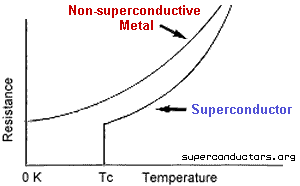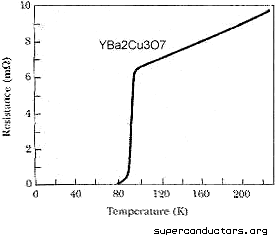Superfluids
Superconductors
There are two categories of superconductors.
Type 1 superconductors:
The first group encompasses superconducting metals and metalloids which have some resistance at normal temperatures, but when cooled past a certain point their resistance becomes 0. The theory currently used to explain this phenomenon is the BCS theory. It states that when sufficiently cooled, electrons form "Cooper Pairs" which enable them to flow unimpeded by molecular obstacles such as vibrating nuclei. It is sort of like two bicyclists drafting behind one another to go faster. The phenomenon is called phonon-mediated coupling because sound is produced in the flexing of the crystal lattice as the electrons pass through it. Type 1 superconductors are perfect diamagnets, meaning they completely repel any magnetic field they are placed in (see superconductors and magnetism). Another cool property of both types of superconductors is that once set up, a current loop will last indefinitely because there is no resistance. This has the potential to store a lot of energy, and American Superconductors Co. already has energy storage backup units for sale for major power companies.

Type 2 superconductors:
The second group is made up of metallic compounds and alloys. These compounds (usually a metal-oxide ceramic) can usually attain higher Tc values, but the mechanism for why they do this is unknown. It is most likely due to planar layering in the crystal lattice (see image in upper left corner of web page - taken from superconductors.org). Some theories predict an upper limit on the Tc of type 2 superconductors, while other theories claim there is no limit. Right now, research in type 2 superconducting is mainly trial and error with different combinations of chemicals. As of the time of this writing, 138K was the highest Tc.Type 2 superconductors are not perfect diamagnets; they allow some penetration of a magnetic field. And they also do not change suddenly from having resistance to having none. There is generally a range of temperatures where there is a mixed state.
